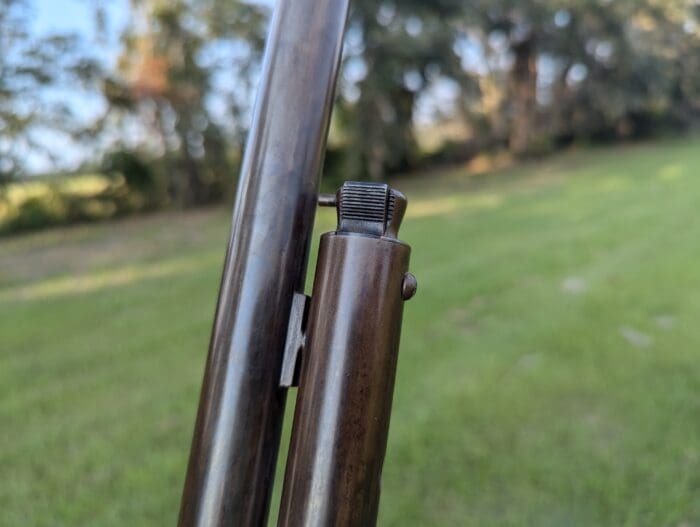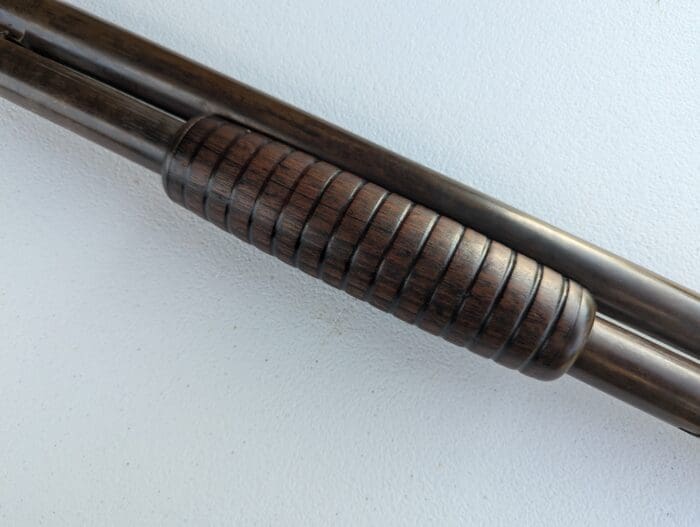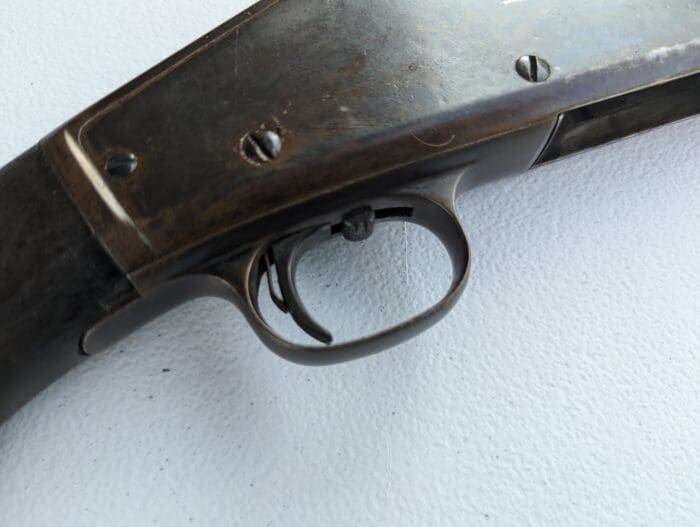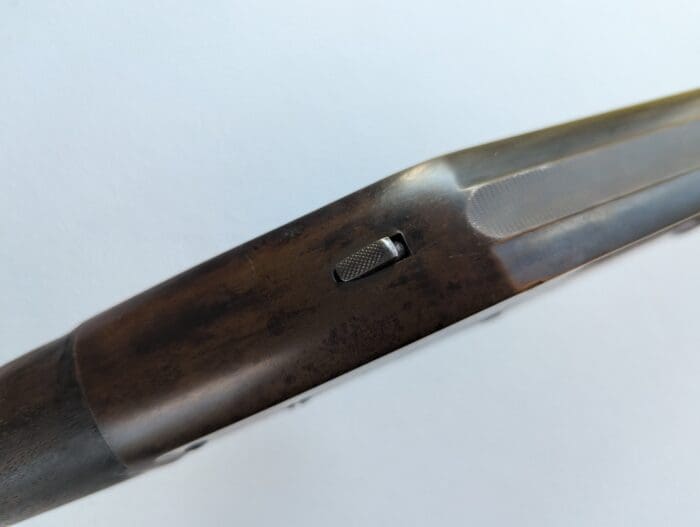If I were to say shotgun company, what would you picture? Remington? Mossberg? Benelli? When I say Marlin, what do you think of? Likely lever action rifles like the Model 336 or the always affordable Marlin Model 60 tube-fed semi-auto .22 LR. Those are understandable associations, but you can also relate Marlin to shotguns. During the turn of the century, Marlin got into the pump-action shotgun world. They produced a ton of different pump-action shotguns, including today’s obscure object of desire, the Marlin Model 28.
The industry took notice when Winchester released the Model 1893. It wasn’t the first pump action, but it was successful, and the Model 1897 was even more successful. That was great for Winchester, but also the industry as a whole. Winchester had to fight off a lawsuit from Francis Bannerman, who owned the rights to the Spencer pump-action shotguns as he produced the first ever pump actions.
Winchester won their case by proving that pump action wasn’t novel to Spencer’s guns. They even found an ancient patent for a pump-action bullpup rifle, which they painfully recreated to prove their point. This allowed Winchester to win the lawsuit but was also a Bat signal to the firearm industry that you can produce pump action shotguns and no one can sue you. Marlin jumped on that revelation and released the Marlin 1898 shotgun.
The Marlin 1898 was a lot like the 1893/1897. It was a pump-action, tube-fed shotgun with an exposed hammer. That was their start, and Marlin produced a variety of both hammer-fired and “hammerless” shotguns, like the Model 28.
The Model 28 – My Mistaken Purchase
I originally bought this gun for two reasons: it was $110, and it was an old shotgun. That’s enough to warrant me opening the wallet. The gun was advertised as a Model 43, and I purchased it as such. However, I broke open Marlin Firearms: A History of the Guns and the Company that Made Them and realized the features and markings didn’t match. I had bought a Model 28.
No harm on my part; I wanted a cheap old shotgun and just so happened to get one that was cheap and even older than I expected. I certainly didn’t mind.


The 28 moniker isn’t a reference to a year, it’s just a model number. The Model 28 was Marlin’s first hammerless shotgun. Production began on the Model 28 in 1913 and lasted until 1923. Marlin boasted at the time that the Model 28 was the “finest repeating gun in the world.” That’s cocky, especially in a world where the Winchester Model 12 existed. The Model 28 in 12 gauge cost $22.60 when it was first introduced. (About $720 today.)


Marlin produced both hammer-fired and hammerless shotguns for years. The Model 42, for example, was a hammer-fired shotgun produced as late as 1922. That same year, they released the Model 43, which eclipsed the Model 28.
The Model 28 In Color
Marlin’s own advertising touted the safety benefits of the gun. They made a big to-do about it being impossible to fire the gun until the bolt was fully forward. This is likely because the Winchester 1893 could be fired out of battery. They also brag about their safety device, claiming, “No simpler, quicker, or more effective device could possibly be designed.” We’ll talk more about that safety later.
The Model 28 came in various configurations. The most base model, and what you see here, is the 28A. A might as well stand for “all around.” It’s the base model that could do a bit of everything. There were also the A, B, C, D and Trap and Trap Special models. B, C and D represented higher models with things like Damascus barrels, higher-quality steels, better wood and better metal finishes.
The Model 28 has a takedown design. The latch system seemed easy to use, but it didn’t move much, and I wasn’t one to force a century-old shotgun to break down. Around the barrel sits a lock nut that can be tightened to eliminate play between the barrel and receiver. This accommodated wear over time and kept the gun locked tight to the receiver without interrupting the takedown design.


The gun held six rounds, which in 1913 was a ton. It was competitive. The Model 28 also had a removable side plate, a lot like a revolver. You could remove the stock, three screws, pop the plate off and have easy access to the internals. The chamber is a proper 2 3/4-inch chamber, so you don’t need to worry about a 2 5/8-inch chamber.
Shooting the Model 28
Before shooting the gun, you have to acquaint yourself with a series of odd controls. Remember that safety? It sits in front of the trigger. Lots of guns use that configuration successfully, but man, it feels a bit risky in this configuration. It sits right in front of the trigger, and it’s a tiny tab that locks a bar behind it. Pulling it rearward to engage the safety just feels risky.


On the top, on the tang, sits a small button. This button unlocks the action if the hammer is cocked and allows you to cycle the gun. A button on the right side allows you to drop one round at a time from the magazine to quickly and efficiently unload the gun. Just don’t have your face anywhere near the bottom of the gun because the shells are launched out of the gun at speeds that would rival me at a taco bar.


The gun’s ancient, and you have to be picky about the ammo you fire through it. Steel shot is a no-no, and I’m not putting ultra-powerful loads through the gun. It feels sturdy. Why risk history to throw some powerful slug downrange? I keep a few boxes of these sub-1,000 FPS trap loads and fired just a few through the gun.


The gun handled the shot surprisingly well. The mashed bead isn’t the best sight, but it works. The action works best when manhandled ever so slightly. The Model 28 needs a vigorous reminder that it’s a pump shotgun.
The Marlin Shotguns
These days, the pump-action shotgun format is the same. It’s interesting to see the varied formats and ergonomic designs various manufacturers tried to pull off before we all settled on the format we all know these days.
A bulletin declaring these guns unsafe was put out by some secondary owner of Marlin. From what I can find, this issue is primarily related to the Marlin 1898. Most people think the hammerless guns are fine. I’m not going to shoot the Model 28 much, but I’ll appreciate every pull of the trigger, every pump of the action and that smell that only old guns seem to have.
Need Ammo? Check out Ammo To Go, the ammunition retail sponsor of TTAG gun reviews and simply a cool online place to fulfill all your ammo needs.
Read the full article here





